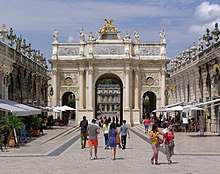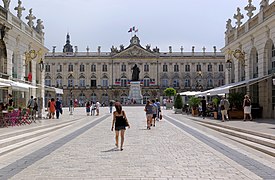Emmanuel Héré

Léopold Emmanuel Héré de Corny (born October 12, 1705 in Nancy , † February 2, 1763 in Lunéville , Département Meurthe-et-Moselle ) was an architect from Lorraine .
Life
Emmanuel Héré was the son of Elisabeth Henry and Paul Herrey (spellings, Hayré, Herré) , a building contractor and migrant from Innsbruck . There is no reliable information about Emmanuel Héré's education. The assumption that Germain Boffrand could have participated in his training has not been proven.
In 1724 he was listed as an architect and in 1729 he worked in the building department in a position subordinate to Philippe Sigisbert Cléret , Jean-François Guesnon , Jean-Nicolas Jennesson and Jean-Nicolas Jadot as a garde-magazin , which is comparable to the activity of a conductor and construction clerk. Héré married Marguerite Duquesnoy in Lunéville in 1729.
When Stanislaus I. Leszczyński arrived, Héré held the position of administrator of the Royal Palace of Lunéville ( capitaine et concierge du château royal de Lunéville ), took over the position of Jennessons from 1737 and became chief architect ( premier architecte de Sa Majesté Polonaise ) of the previous one in 1738 Appointed King of Poland and Grand Duke of Lithuania Stanislaus I. Leszczyński in the Duchy of Lorraine and Bar . He held this office until 1753.
From Lunéville, he managed the planning and expansion of the ducal palaces and parks and was entrusted with urban planning projects. The building management was responsible for looking after the buildings and parks of Castle Lunéville , Castle Commercy , Castle Chanteheux , Castle La Malgrange , Castle Einville and Castle Jolivet .
In 1751, Emmanuel Héré learned from Stanislas I the elevation to the nobility, which in 1752 by Louis XV. has been confirmed. In 1753 he acquired Corny Castle on the Moselle , south of Metz , in exchange for a property developed in Nancy .
The best-known artists and artisans with whom Héré worked on the construction of the buildings are the sculptors Dieudonné-Barthélémy Guibal , Paul-Louis Cyfflé and Jean Girardet, as well as the blacksmith Jean Lamour . His successor was his colleague Richard Mique in 1753 , who from 1775 took the position of Ange-Jacques Gabriel as chief architect of the kings Louis XV. and Louis XVI. took over.
A reconstruction of Héré's work faces the problem of the loss of numerous primary sources. After the duchy was annexed to France in 1766, the existing archives were dissolved. Many of the written sources were lost. The union of Lorraine with France was followed by the destruction of numerous facilities on the orders of Louis XV after 1766. A large part of Emmanuel Héré's work was also lost.
Charisma
Héré's work was particularly characterized by a large number of smaller buildings that were built within the gardens in Lorraine. The ephemeral design of garden buildings was a common phenomenon in contemporary buildings across Europe. This construction method found a parallel in the temporary festival architecture of the 16th and 17th centuries. The special living conditions of the client and the limited means available for representing and maintaining the status as King of Poland explain the construction of small, inexpensive pavilions. Héré's work was discredited for a long time due to the unsound construction method and its unusual design language, which did not correspond to the classical architecture concept in France. They were pejoratively referred to as style jésuite .
With the loss of the architectural work that followed the death of Stanislas I, Héré's contribution to the development of French garden architecture was forgotten. Without the pavilions built in the Lorraine Gardens, the Kiosque (1737), the Trèfle Pavilion (1738) or the Chanteheux Pavilion (1741), a description of the further developments of the landscape park is incomplete, also with regard to the work of William Chambers in English Landscape park . Later complexes in Versailles, such as the Petit Trianon , built by Ange-Jacques Gabriel (1762–1768) or the Hameau planned by Richard Mique in 1782, developed out of the increasing need for privacy. The use of the Chartreuses built in Lunéville in 1753 provided a model for this. In the way they were used and the way they were built, they were an expression of contemporary ideas - Voltaire and Montesquieu their “residents” .
Works
- 1738 to 1741 Notre-Dame-de-Bonsecours Church , Nancy
- 1737 to 1753 Lunéville Castle
- to 1753 more garden architectures Castle Commercy , Castle La Malgrange and Castle Chanteheux
- 1750 Tribunal Administratif , Nancy
- 1751 to 1753 Palais du Gouvernement , Nancy
- 1752 to 1754 Arc Héré , Nancy
- 1752 to 1755 Opéra de Nancy et de Lorraine , Nancy
- 1752 to 1757 Place Stanislas , Nancy
- 1752 to 1755 Hôtel de Ville , Nancy
- 1755 Grand Hotel , Nancy
- 1755 Musée des Beaux-Arts , Nancy
Publications
- In 1753, Héré published a number of his buildings as copper engravings.
literature
- Chapotot, Stephanie. 1999. Les jardins du roi Stanislas en Lorraine. préface de François Pupil. Metz: Editions Serpenoise.
- Rau-von der Schulenburg, Julia. 1973. Emmanuel Héré, Stanislas Leszczynski's premier architecte in Lorraine. 1705-1763. Frankfurt research on the history of architecture. Vol. 4., Berlin: Gebr. Mann Verlag.
Web links
- Appreciation and biographical information
- Avcioğlu, Nebahat. 2003. A Palace of One's Own: Stanislas I's Kiosks and the Idea of Self-Representation. In: The Art Bulletin .
| personal data | |
|---|---|
| SURNAME | Héré, Emmanuel |
| ALTERNATIVE NAMES | Héré de Corny, Léopold Emmanuel |
| BRIEF DESCRIPTION | Lorraine architect |
| DATE OF BIRTH | October 12, 1705 |
| PLACE OF BIRTH | Nancy |
| DATE OF DEATH | February 2, 1763 |
| Place of death | Luneville |



